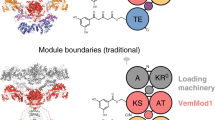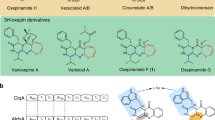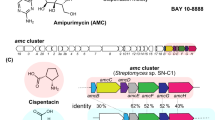Abstract
The ORFVI from the cluster of genes, which is responsible for the biosynthesis of the Streptomyces coelicolor spore pigment, the whiE cluster, has been described as a bifunctional aromatase/cyclase. In order to evaluate its potential use for generating novel polyketides, combinations of this gene with those encoding minimal polyketide synthase enzymes with or without a ketoreductase from S. coelicolor A3(2) were constructed and analyzed in vivo. Analysis of the polyketide products generated from these constructs indicates that the whiE-ORFVI enzyme has properties similar to those of TcmN, although the whiE aromatase/cyclase normally acts on a polyketide intermediate that is four carbons longer than the TcmN substrate. The whiE aromatase/cyclase can influence the regiospecificity of the first cyclization of unreduced, but not reduced, backbones and is also responsible for the second ring aromatization. An unusual new polyketide, EM18, was identified which is not seen in equivalent strains expressing the tcmN aromatase/cyclase or the act aromatase genes. The structure of EM18 suggests that the whiE-ORFVI product might have some unique properties within this family of polyketide synthase subunits, and may therefore be useful in the design of combinatorial biosynthetic strategies.
This is a preview of subscription content, access via your institution
Access options
Subscribe to this journal
Receive 12 print issues and online access
$209.00 per year
only $17.42 per issue
Buy this article
- Purchase on Springer Link
- Instant access to full article PDF
Prices may be subject to local taxes which are calculated during checkout
Similar content being viewed by others
References
O'Hagan, D. 1991. The Polyketide Metabolites. Ellis Horwood, Chichester, U.K.
Katz, L. and Donadio, S. 1993. Polyketide synthesis: prospects for hybrid antibiotics. Ann. Rev. Microbiol. 47: 875–912.
Hallam, S.E., Malpartida, F. and Hopwood, D.A. 1988. Nucleotide sequence, transcription and deduced function of a gene involved in polyketide antibiotic synthesis in Streptomyces coelicolor . Gene 74: 305–320.
Bibb, M.J., Biro, S., Motamedi, H., Collins, J.F. and Hutchinson, C.R. 1989. Analysis of the nucleotide sequence of the Streptomyces glaucescens tcml genes provides key information about the enzymology of polyketide tetracenomycin C antibiotic biosynthesis. EMBO J. 8: 2727–2736.
Sherman, D.H., Malpartida, F., Bibb, M.J., Kieser, H.M., Bibb, M.J. and Hopwood, D.A. 1989. Structure and deduced function of the granaticin-producing polyketide synthase gene cluster of Streptomyces violaceoruber Tü22. EMBO J. 8: 2717–2725.
Davis, N.K. and Chater, K.F. 1990. Spore color in Streptomyces coelicolor A3(2) involves the developmentally regulated synthesis of a compound biosynthetically related to polyketide antibiotics. Mol. Microbiol. 4: 1679–1692.
Fernández-Moreno, M.A., Martínez, E., Boto, L., Hopwood, D.A. and Malpartida, F. 1992. Nucleotide sequence and deduced functions of a set of cotranscribed genes of Streptomyces coelicolor A3(2) including the polyketide synthase for the antibiotic actinorhodin. J. Biol. Chem. 267: 19278–19290.
Summers, R.G., Wendt-Pienkowski, E., Motamedi, H. and Hutchinson, C.R. 1992. Nucleotide sequence of the tcmII-tcmIV region of the tetracenomycin biosynthetic gene cluster of Streptomyces glaucescens and evidence that the fcmN gene encodes a multifunctional cyclase-dehydratase-O-methyltransferase. J. Bacteriol. 174: 1810–1820.
Bergh, S. and Uhlen, M. 1992. Analysis of a polyketide synthesis encoding gene cluster of Streptomyces curacoi . Gene 117: 131–136.
Summers, R.G., Wendt-Pienkowski, E., Motamedi, H. and Hutchinson, C.R. 1993. The tcmVI region of the tetracenomycin C biosynthetic gene cluster of Streptomyces glaucescens encodes the tetracenomycin F1 monooxygenase, tetracenomycin F2 cyclase, and, most likely, a second cyclase. J. Bacteriol. 175: 7571–7580.
Blanco, G., Brian, P., Pereda, A., Méndez, C., Safas, J.A. and Chater, K.F. 1993. Hybridization and DNA sequence analyses suggest an early evolutionary divergence of related biosynthetic gene sets encoding polyketide antibiotics and spore pigments in Streptomyces spp . Gene 130: 107–116.
Yu, T.W., Bibb, M.J., Revill, W.P. and Hopwood, D.A., 1994. Cloning, sequencing, and analysis of the griseusin polyketide synthase gene cluster from Streptomyces griseus . J. Bacteriol. 176: 2627–2634.
Bibb, M.J., Sherman, D.H., Omura, S. and Hopwood, D.A., 1994. Cloning, sequencing and deduced functions of a cluster of Streptomyces genes probably encoding biosynthesis of the polyketide antibiotic frenolicin. Gene 142: 31–39.
Kim, E.S., Bibb, M.J., Butler, M.J., Hopwood, D.A. and Sherman, D.H. 1994. Sequences of the oxytetracycline polyketide synthase-encoding otc genes from Streptomyces rimosus . Gene 141: 141–142.
Ye, J., Dickens, M.L., Plater, R., Li, Y., Lawrence, J. and Strohl, W.R. 1994. Isolation and sequence analysis of polyketide synthase genes from the daunomycin-producing Streptomyces sp. strain C5. J. Bacteriol. 176: 6270–6280.
Grim, A., Madduri, K., Ali, A. and Hutchinson, C.R. 1994. Characterization of the Streptomyces peucetius ATCC 29050 genes encoding doxorubicin polyketide synthase. Gene 151: 1–10.
McDaniel, R., Khosla, E., Hopwood, D.A. and Khosla, C. 1993. Engineered biosynthesis of novel polyketides. Science 262: 1546–1550.
McDaniel, R., Khosla, E., Hopwood, D.A. and Khosla, C. 1993. Engineered biosynthesis of novel polyketides: manipulation and analysis of an aromatic polyketide synthase with unproven catalytic specificities. J. Am. Chem. Soc. 115: 11671–11675.
Fu, H., Khosla, E., Hopwood, D.A. and Khosla, C. 1994. Engineered biosynthesis of novel polyketides: dissection of the catalytic specificity of the act ketoreductase. J. Am. Chem. Soc. 116: 4166–4170.
Fu, H., Hopwood, D.A. and Khosla, C. 1994. Engineered biosynthesis of novel polyketides: evidence for temporal, but not regiospecific, control of cyclization of an aromatic polyketide precursor. Chem. Biol. 1: 205–210.
Fu, H., McDaniel, R., Hopwood, D.A. and Khosla, C. 1994. Engineered biosynthesis of novel polyketides: stereochemical course of two reactions catalyzed by a polyketide synthase. Biochemistry 33: 9321–9326.
Fu, H., Khosla, E., Hopwood, D.A. and Khosla, C. 1994. Relaxed specificity of the oxytetracycline polyketide synthase for an acetate primer in the absence of a malonamyl primer. J. Am. Chem. Soc. 116: 6443–6444.
McDaniel, R., Khosla, E., Hopwood, D.A. and Khosla, C. 1994. Engineered biosynthesis of novel polyketides: the actVII and actIV genes encode aromatase and cyclase enzymes, respectively. J. Am. Chem. Soc. 116: 10855–10859.
McDaniel, R., Khosla, E., Fu, H., Hopwood, D.A. and Khosla, C. 1994. Engineered biosynthesis of novel polyketides: influence of a downstream enzyme on the catalytic specificity of a minimal aromatic polyketide synthase. Proc. Natl. Acad. Sci. USA. 91: 11542–11546.
McDaniel, R., Hutchinson, C.R. and Khosla, C. Engineered biosynthesis of novel polyketides: analysis of tcmN function in tetracenomycin biosynthesis. J. Am. Chem. Soc. 117: 6805–6810.
McDaniel, R., Khosla, E., Hopwood, D.A. and Khosla, C. 1995. Rational design of aromatic polyketide natural products by recombinant assembly of enzymatic subunits. Nature 375: 549–554.
Yu, T.-W. 1995. Physical and functional studies of polyketide synthesis genes of Streptomyces . Ph.D. thesis, University of East Anglia, Norwich, U.K.
Tsoi, C.J. and Khosla, C. 1995. Combinatorial biosynthesis of “unnatural” natural products: the polyketide example. Chem. & Biol. 2: 355–362.
Cerdá-Olmedo, E. 1994. The genetics of chemical diversity. Crit. Revs. in Microbiol. 20: 151–160.
Maniatis, T., Fritsch, E.F. and Sambrook, J. 1982. Molecular Cloning: A Laboratory Manual, Cold Spring Harbor Laboratory, Cold Spring Harbor, New York.
Hopwood, D.A., Bibb, M.J., Chater, K.F., Kieser, T., Bruton, C.J., Kieser, H.M., Lydiate, D.J., Smith, C.P., Ward, J.M. and Schrempf, H. 1985. Genetic Manipulation of Streptomyces: A Laboratory Manual. The John Innes Foundation: Norwich, U.K.
Author information
Authors and Affiliations
Rights and permissions
About this article
Cite this article
Alvarez, M., Fu, H., Khosla, C. et al. Engineered Biosynthesis of Novel Polyketides: Properties of the whiE Aromatase/Cyclase. Nat Biotechnol 14, 335–338 (1996). https://doi.org/10.1038/nbt0396-335
Received:
Accepted:
Issue Date:
DOI: https://doi.org/10.1038/nbt0396-335
This article is cited by
-
An aberrant metabolic flow toward early shunt products in the granaticin biosynthetic machinery of Streptomyces vietnamensis GIMV4.0001
The Journal of Antibiotics (2020)
-
New bhimamycins from Streptomyces sp. AK 671
The Journal of Antibiotics (2013)
-
Controlled proliferation by multigene metabolic engineering enhances the productivity of Chinese hamster ovary cells
Nature Biotechnology (1998)
-
Complete conversion of antibiotic precursor to pristinamycin IIA by overexpression of Streptomyces pristinaespiralis biosynthetic genes
Nature Biotechnology (1997)



